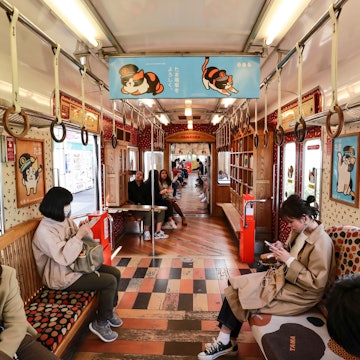

Maps are the most popular thing to look at on an airplane screen. Kosamtu / Getty Images
When you settle down to watch a movie in your airplane seat, have you ever wondered how it got there? Let’s go behind the scenes on how that movie that just left the theatre makes it very quickly onto your flight.
To get the low-down, I asked Catherine Brown from Bluebox, one of the companies that makes the systems on board, to explain how it all works.
What are people watching on airplanes?
Breaking out the stats, she says that “across all our customers the most popular are the big movies from Hollywood. In terms of hours of play, movies lead with about 65% of time spent being watched, but you might be surprised that even more popular than any movie is the map! In one month at one airline 22% of all items accessed was the map.
"Not every airline offers this but when it’s available the map seems to be the most frequently requested individual item by far. I guess it’s that ‘where am I right now?’ thought between movies when all you can see below you are clouds. From TV content, comedy is the most popular — for one customer representing about 45% of the TV programmes watched.”
But many airlines and their passengers prefer watching local specialties. “Our Indian customer Vistara’s Bollywood collection is by far more popular than the selection of Hollywood movies it offers, so it depends on the airline and their passengers’ tastes,” Brown explains. “Air Astana in Kazakhstan has a large backlog of older or classic Hollywood movies, Air Inuit — a regional Canadian airline — has classic Canadian TV programmes and hockey-related content, while ANA in Japan has a lot of content about golf.”
One of the reasons these Hollywood films are so popular is what’s known as the “early window”: the shrinkingly short time between when movies leave theatres and arrive for home use on DVD, streaming or download, when they are specifically licensed for use in public places like aircraft. Essentially, you can see that movie you missed in the theatres, weeks or months before you can watch it at home.
There’s also an interesting aspect to people’s online viewing habits where passengers indulge in movies that they wouldn’t ordinarily have gone to the theatre to see, like people without kids watching the latest Disney movie, for example, or something indulgently lowbrow.
Read more: What's the best seat on a flight?
With new planes featuring systems with more storage, and upgraded systems on older jets, airlines are offering more movies, TV shows, music, podcasts, games and other content than ever. Cathay Pacific just this week quadrupled the amount of content, saying “customers could fly non-stop around the world 45 times and never have to watch the same thing twice.”

How do movies get on the plane?
“Movies and other types of content — music, magazines, et cetera — get onto airplanes lots of ways, depending on the type of entertainment system you’re using. Screens on back of seats will be connected to a server on the plane that will be updated regularly by the airline’s inflight entertainment team,” Bluebox’s Catherine Brown explains.
“The systems we supply are literally carried onto the plane — our main wireless system, Bluebox Wow, is a box about the size of a lunchbox that sits in an overhead bin, and then passengers connect to it wirelessly from their tablet or smartphone,” she notes. “These boxes are updated by swapping out their memory cards. Movies need to be updated this way because of the size of the video files, but we can also update smaller types of content — like newspapers — wirelessly as well, once the plane is on the ground and the box connects to the internet.”
Who chooses the movies and other content on your plane entertainment system?
“The airline will have final say, but they’ll work with partner companies — content service providers — who help with content curation, helping choose the latest movies item-by-item, or offering bundles from specific studios. They’ll also manage all the licensing with the studios that must be arranged in order to legally show that content to you on a plane. That’s a whole other complex topic!” she says, laughing. For big airlines, there may be a special team of people whose job this all is. For a smaller airline, it might be the same person who’s responsible for the onboard catering or even the seats.

Almost all content is edited in some way, whether that’s to change from movie widescreen to the shape of the monitors, or to cut out steamy or violent scenes — or those involving airline crashes. If you look carefully, you’ll often spot edits or censorship when the airline’s name or two-letter code pops up on the screen.
And while some airlines have a great range of diverse content, others are known as heavy censors. You might find episodes of 'RuPaul’s Drag Race' on Finnair, or 'The Rocky Horror Picture Show' on British Airways this month but there are certain parts of the world where you won’t find LGBTQIA content, where a high-necked shirt will be photoshopped on visible cleavage, and so on. (There’s even one airline, which will remain nameless, where any reference to American Airlines in the George Clooney movie 'Up In The Air' was removed, down to changing the red-white-and-blue on the planes.)
Can people with vision impairments use the onboard entertainment system?
After a bit of a slow start, many airlines are now taking steps to include passengers who are blind or who have visual impairments in their inflight entertainment options. “On one of our inflight entertainment systems — our iPad-based IFE — we developed an alternative screen with the needs of visually impaired passengers in mind. It uses the iPads’ VoiceOver accessibility feature to ‘read’ the menu selections on the screen for someone who has no sight at all, but it is also designed in high-contrast, black & white, and large type so someone with limited vision can see what’s on offer,” Brown explains.
“Each page is designed consistently so the user can quickly familiarise themselves with the menu structure and where certain actions are — play, help, et cetera. The feedback we’ve had — from the user group of visually impaired people who helped us build it but also passengers using it on flights — was that this was incredible for them, because as IFE system technology advanced, mainly to include touch screens, they actually lost their ability to navigate systems that previously had physical buttons to aid selections.”
So next time you’re flipping through the selections, think about all the people who brought you that movie, TV show or even just the moving map, and how they’re working to make the entertainment accessible for everyone on the plane.














